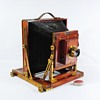Posted 10 years ago
 rniederman
rniederman
(346 items)
When considering a key evolutionary point in the history of photographic apparatus representing the transition to truly portable ‘cased’ camera designs, we have to look all the way back to 1880 and Thomas Blair’s original Tourograph. It was envisioned as a complete, portable photographic system.
This is an amazingly rare camera (only one known of this particular version) and a historically significant part of my collection. While a very cool looking camera it was an utter failure in regards to practicality. The original 1880 company brochure said that “The Tourograph is a complete instrument for the mechanical exposing of Photographic "Dry Plates" upon such subjects as the user is desirous of obtaining negatives.”
Okay ... that’s a mouthful, but what was being advertised is a camera that carried its glass plates inside the body. All the photographer had to do was include a tripod and everything needed to make pictures was in hand.
Blair's design approach was to encase all delicate components within the wooden camera body, a concept that was eventually refined in 1883 by Frank Pearsall (his camera is also posted here on CW). Although the Tourograph is considered one of the first portable, self-contained cameras for amateurs, Blair's design ended up being needlessly complex for daily use.
Unlike field view cameras of the day that had swing-away ground glass frames and simple methods to mount plate holders, Tourograph users had to learn a tedious sequence of steps to compose and shoot a single plate. In other words, the Tourograph approach to photography sacrificed simplicity for portability.
Raising the hinged rear panel reveals a fabric changing sleeve set into a swing-out wooden frame; allowing photographers to safely lower and raise a ground glass or plates by hand.
To compose and focus, a ground glass (usually in plate box slot 1) is dropped into a wooden frame inside the camera body. The sleeve and its frame are then swung to the side to view the ground glass and focus a sharp image.
Because the internal wooden frame must be moved out of the image plane of focus to load a new photographic plate, a temporary mark is made on the brass distance strip.
To keep everything orderly, Blair created an indexing system to ensure that the wooden frame aligns with any of the nine plate box slots. A second brass strip embossed with nine corresponding hash lines serves as a guide.
The photographer turns the focus knob until the desired plate's hash mark butts up to the body. The third picture illustrates how the brass strip index corresponds to a plate box slot. The matching numbered brass slide is then pulled outward and the plate gently guided into place using the fabric sleeve.
Finally, the unexposed photographic plate is moved back into the image's focus plane by returning to the reference mark on the brass distance strip.
This process is repeated for each new picture.
And there you have it ... the origins of true portable photography back in 1880!


























stunning Rob, and the history is awesome!!!!
You're lucky to own such an historically significant camera as this.
Not exactly point & shoot, as you say tedious & complex.
Wouldn't he be amazed to see people today walking around with cameras in their pockets.
Damn! & I thought using a light meter was complicated in the 50's! Good write-up! Thanks.
Thanks!
Sean
PatSea
Thanks, David! I agree ... the early photographic pioneers would be amazed.
Thanks!
Manikin
vetraio50
aghcollect
Thanks!
Michael
blunderbuss2
Thanks, Ben and Eric!
Thanks, hotairfan!
Thanks, AntigueToys!
Thanks, trukn20!
Thanks, mtg75!
Thanks, stelios!
Thanks, petey!
Thanks, Camera_turk!